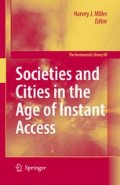Access this chapter
Tax calculation will be finalised at checkout
Purchases are for personal use only
Preview
Unable to display preview. Download preview PDF.
References
Brimicombe A. and Li Y. (2006): ‘‘Mobile Space-Time Envelopes for Location-Based Services’’. Transactions in GIS 10(1): 5–23
Boswell, S. (1995): ‘‘The splintering of student geographies: Restructuring of the tertiary education sector in New Zealand.’’ Unpublished M.A. Thesis. Department of Geography, University of Auckland, New Zealand.
Cairncross F. (1997): ‘‘The Death of Distance’’. Harvard Business School Press, 302pp
Corbett J (2002): ‘‘Torsten Hagerstrand: Time Geography’’, Centre for Spatially Informed Social Science, University of California Santa Barabara, http://www.csiss.org/classics/content/29
Couclelis H. and Getis A. (2000): ‘‘Conceptualizing and measuring accessibility within physical and virtual spaces,’’ in D. G. Janelle and D. C. Hodge (eds.) Information, Place and Cyberspace: Issues in Accessibility, Berlin: Springer, 15–20.
Dias, E., Beinat, E., Rhin, C. and Scholten, H. (2004): ‘‘Location Aware ICT in Addressing Protected Areas’ Goals’’. Research on computing Science vol. 11 (special edition on e-Environment). Edited by Prastacos, P. and Murillo, M. Centre for Computing Research at IPN. Mexico City. p.273–289.
Forer, P.C. (2005): ‘Tourism Flows and Dynamic Geographies: Applying GI Science to Understanding Tourist Movements and Impact.’ In Simmons D. and Fairweather J. (editors) ‘Understanding the Tourist Host-Guest Encounter in New Zealand’, EOS Publishers, Christchurch, New Zealand, 22–56
Forer, P.C. and O. Huisman (2000): ‘‘Space, Time and Sequencing: Substitution at the Physical/Virtual Interface’’. In Janelle D.G. and Hodge D.C. (eds), Information, Place and Cyberspace: Issues in Accessibility, Springer-Verlag, Berlin, 73–90.
Hägerstrand, T. (1970): ‘‘What about people in regional science?’’ Papers of the Regional Science Association 24: 7–21.
Hägerstrand, T. (1978): ‘‘Survival and arena: On the life–history of individuals in relation to their geographical their Geographical Environment (1975). Monadnock Vol. 49: 9–29. Clark University
Hägerstrand, T (1995): ‘‘Action in the physical everyday world’’ In A.D. Cliff, P.R. Gould, A.G. Hoare and N.J. Thrift (eds). Diffusing Geography: Essays for Peter Haggett. Blackwell,Oxford, pp. 35–45
Kwan, M.-P. (1998): ‘‘Space-time and integral measures of accessibility: A comparative analysis using a point-based framework’’, Geographical Analysis, 30, 191–216.
Kwan, M.-P. (1999): ‘‘Gender and individual access to urban opportunities: A study using space-time measures’’, Professional Geographer, 51, 210–227.
Laube P, Imfeld S. and Weibel R. (2005): ‘‘Discovering relative motion patterns in groups of moving point objects’’, International Journal of Geographical Information Science, Vol. 19, No. 6, July 2005, 639–668
Mcdowall C. (2006): Modelling vague dynamic entities within a GIS. Thesis presented for the degree of Doctor of Philosophy, University of Auckland
Miller, H.J. (2005): ‘‘What about people in geographic information science?’’ In Re–Presenting Geographical Information Systems. P. Fisher and D. Unwin.(editors), John Wiley, 215–242.
Miller, H.J. (1991): ‘‘Modelling accessibility using space–time prism concepts within geographical information systems’’. International Journal of Geographical Information Systems 5(3): 287–301.
Miller H.J, Wu, Y. (2000): ‘‘GIS software for measuring space–time accessibility in transportation planning and analysis’’. GeoInformatica 4:141–159
Mitchell, P (in press): ‘‘ICTs and Emerging Timespaces: The Role of Local Government in the Auckland ICT Environment’’, Social and Cultural Geography special issue on Spatial Technologies/Technological Spaces.
Mountain D. and Raper J. (2001): ‘‘Modelling human spatio-temporal behaviour: A challenge for location-based services’’: Proceedings of the 6th International Conference on GeoComputation, University of Queensland. ‘‘GeoComputation CD-ROM’’ Publisher David V. Pullar,, or at http://www.soi.city.ac.uk/∼dmm/research/pubs/B05.3.pdf
Norris P. (2001): ‘‘Digital Divide: Civic Engagement, Information Poverty, and the Internet Worldwide. Cambridge University Press, Cambridge 320 pp
Parkes, D. N. and N. J. Thrift (1980): ‘‘Times, Spaces, and Places: A Chronogeographic Perspective’’., John Wiley & Sons, Chichester, 524 pp.
Pred, A.,(ed.) (1981): ‘‘Space and time in geography: Essays dedicated to Torsten Hagestrand’’. Gleerup, Lund
Karlqvist A. Lundqvist L. and Snickars F. (eds) (1975): ‘‘Dynamic Allocation of Urban Space’’. Saxon House, Westmead, 280 pp
Stewart I. and Cohen J. (1999): ‘‘Figments of Reality: The Evolution of the Curious Mind’’, Cambridge University Press, 340 pp
Telecom New Zealand 2005: ‘‘Mapping of national and local coverage areas for mobile phone and data communications’’. July 2005. Telecom New Zealand, Wellington, 4pp
Thrift N. and French S. (2002): ‘‘The automatic production of space’’, Transactions of the Institute of British Geographers, Volume 27, Number 3, 309–335(27)
Author information
Authors and Affiliations
Editor information
Editors and Affiliations
Rights and permissions
Copyright information
© 2007 Springer
About this chapter
Cite this chapter
Forer, P., Huisman, O., McDowall, C. (2007). Dynamic prisms and ‘‘instant access’’: linking opportunities in space to decision making in time. In: Miller, H.J. (eds) Societies and Cities in the Age of Instant Access. The GeoJournal Library, vol 88. Springer, Dordrecht. https://doi.org/10.1007/1-4020-5427-0_8
Download citation
DOI: https://doi.org/10.1007/1-4020-5427-0_8
Publisher Name: Springer, Dordrecht
Print ISBN: 978-1-4020-5426-6
Online ISBN: 978-1-4020-5427-3
eBook Packages: Earth and Environmental ScienceEarth and Environmental Science (R0)

